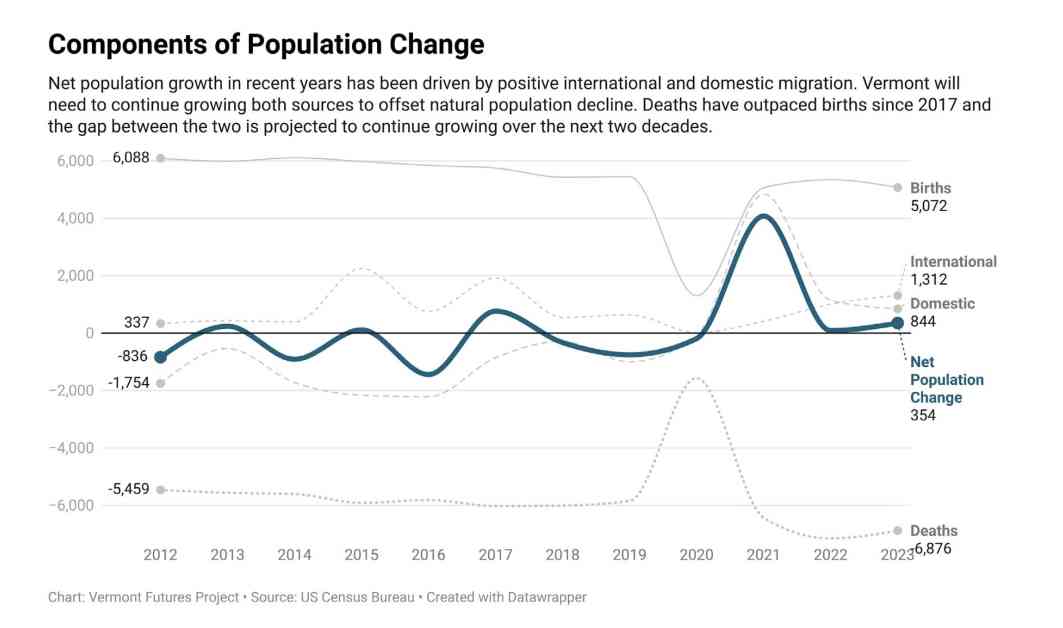Vermont’s Economic Growth Plan: Adding 13,500 Workers Annually
Vermont faces a crucial challenge in the coming years: adding around 13,500 workers to its labor force annually to meet growing demands and sustain economic growth. The Vermont Futures Project, a forward-thinking organization, recently unveiled its inaugural Economic Action Plan at the Vermont Chamber of Commerce’s annual conference, aiming to provide a roadmap for the state’s economic prosperity by significantly boosting its population and housing availability.
The Executive Director of the Vermont Futures Project, Kevin Chu, emphasized the plan’s focus on addressing the root causes behind the rising cost of living in Vermont. These issues primarily revolve around two key factors: the state’s housing crisis and the widening workforce gap. The workforce gap, as highlighted in the plan, refers to the imbalance between the number of individuals exiting the labor force each year and those entering it.
Data from the Vermont Department of Labor, as cited in the plan, projects that approximately 17,150 Vermonters will retire annually over the next decade. Meanwhile, an estimated 4,550 jobs are expected to become available each year due to various factors, including job creation. However, with only 8,200 individuals projected to join the workforce annually, Vermont faces a significant shortfall, necessitating the addition of 13,500 new workers each year to bridge the gap effectively.
This ambitious goal would raise Vermont’s population to over 800,000 residents by 2035, representing a substantial increase from its current numbers. Yet, achieving such growth poses numerous challenges for the state, which has historically struggled with stagnant population growth. Recent census data indicated minimal population growth in the state, with a year-over-year decline reported in 2024, the first since 1957.
The plan also acknowledges the strain that such rapid population growth would place on Vermont’s housing market. The average price of a single-family home in the state saw a significant 38% increase between 2019 and 2023, reflecting the existing challenges in the housing sector. To accommodate the influx of new residents required to meet labor demands, the plan suggests the construction of over 60,000 housing units over the next decade.
Kevin Chu emphasized the need for collaborative efforts to achieve these ambitious long-term goals, recognizing that it will require collective action from various stakeholders. The plan outlines a series of strategies to facilitate this growth, including targeted marketing campaigns to attract migrants to Vermont and creating incentives for veterans to settle in the state by exempting military pensions from state taxes.
Furthermore, the plan proposes a 40% reduction in development timelines and regulatory costs over the next decade, emphasizing the need to streamline Vermont’s bureaucratic processes, including regulations, zoning laws, and appeals procedures. However, some analysts question whether prioritizing population and economic growth is the most effective strategy for Vermont.
Steph Yu, Executive Director of the Public Assets Institute, highlighted concerns regarding wealth distribution in the state, suggesting that addressing the wage gap and increasing government investments may be more effective at improving the lives of Vermonters. Yu emphasized the importance of considering the challenges faced by many Vermont families, including housing affordability and healthcare costs, advocating for a more comprehensive approach to address these issues.
As Vermont navigates the complex landscape of economic growth and population expansion, the path forward remains unclear. Balancing the need for increased workforce numbers with the challenges of housing affordability and wealth distribution presents a multifaceted dilemma for policymakers and stakeholders alike. Only time will tell whether Vermont can successfully navigate these challenges and emerge stronger on the other side, poised for sustainable growth and prosperity.









